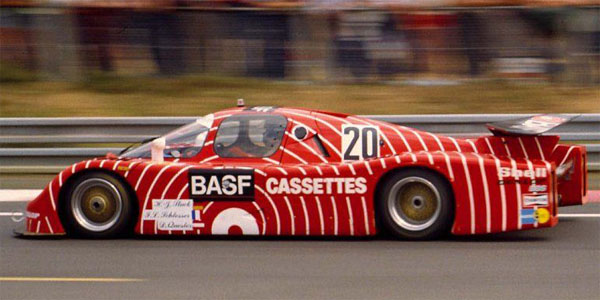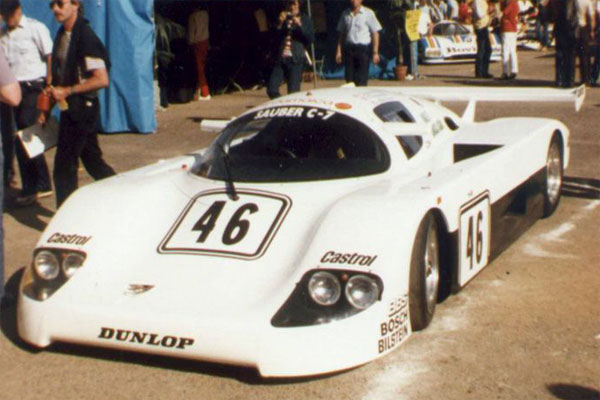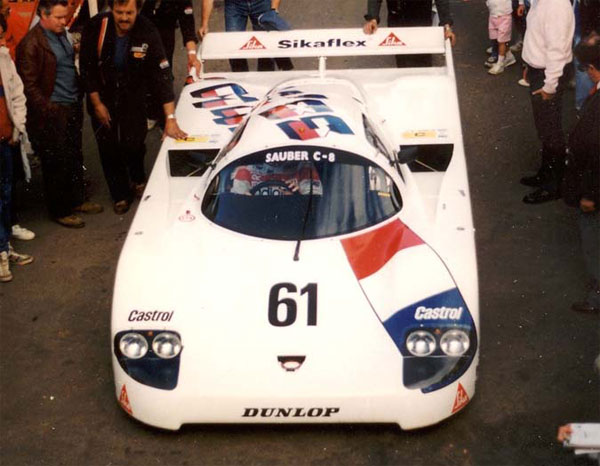|
|
32767 view(s)  Technical superiority, pure and simple, led the C9 to record the fastest lap times in 12 out of 20 races, earn fifteen podium finishes and score brilliant 1st, 2nd and 5th place finishes at 1989 24 Hours of Le Mans. The support and efforts of Peter Sauber were paramount to the return of Mercedes-Benz to international racing in 1988. The C9 won 5 of 11 major races that year. In 1989, however, the thoroughbred changed its colors and became the new Silver Arrow. In this classic livery Mercedes clinched the World Sports Car Championship Technical superiority, pure and simple, led the C9 to record the fastest lap times in 12 out of 20 races, earn fifteen podium finishes and score brilliant 1st, 2nd and 5th place finishes at 1989 24 Hours of Le Mans. The support and efforts of Peter Sauber were paramount to the return of Mercedes-Benz to international racing in 1988. The C9 won 5 of 11 major races that year. In 1989, however, the thoroughbred changed its colors and became the new Silver Arrow. In this classic livery Mercedes clinched the World Sports Car Championship
1970 The first C's climbing the hill.
Peter Sauber was trained as electrician but was always fascinated by automobiles, which in itself was unusual as practically all motor racing had been banned in Switzerland since his childhood. Sauber took his first steps as a racer/constructor when he won the local championship in 1969 in a self modified racing Beetle (known by his rivals as "The Cheese Sandwich") Starting his own racing business in 1970 his first "official" Sauber was a stripped down one-liter Brabham-Cosworth racer. Using the major mechanical components as the basis for a spaceframe car, the C1.( "C" standing for Christiane, his wife) Winning the Swiss hillclimb championship Peter decided to concentrate on building better cars letting others drive them. Unveiling the Sauber C2 at the 71 Geneva Auto Salon followed by his first monocoque design the C3 and his final hillclimber the C4.
1976 C5 on the road.. to Le Mans
With the C5 Sauber left the Swiss mountains and went road racing. The C5 was a sportscar which Sauber entered in Group 6 of the Interserie championship. Powered by a 2-liter BMW engine and driven by Herbert Muller the C5 won the title and in 1977 Sauber entered the car for the Le Mans 24 Hours. Driven by Swiss drivers Eugen Strahl and Peter Bernhard the car led its class but retired. A year later Sauber returned to Le Mans with Strahl and Harry Blumer joined by Swiss new rising star Marc Surer. Again the car led its class but dropped back with engine trouble.
As an independent constructor money was always in short supply, causing Sauber to stop building prototypes 1979 and prepare Lola F3 cars for the Swiss national championship. He his drivers Blatter, Kobelt and Max Welti finishing first, second and fourth in the series, but more significant was Welti also joining Sauber as team manager. Sauber then turned to preparing BMW M1's for Marc Surer, building the winning M1 of the 1981 Nurburgring 1000 sportscar (with Stuck and Piquet).
1982 C6 as in...Group C
By 1982, Peter Sauber returned as a constructor entering the then new Group C with a 2 car team. The Sauber C6 was still a low-key effort but did have Ford Cosworth DFL V8's, longtail bodywork, Basf sponsoring and good drivers (Brun, Müller, Quester, Schlesser and Stuck) Although the fastest C6 managed to qualify as high as 7th (3:33.25) bot cars did not finish (#19 starter motor 55 laps, #20 Engine mountings 76 laps). But over the season the team improved gradually and managed to finish the WSC tied for 5th.
1983 C7 going after the Porsches
With 1982 over, Sauber realised that if he wanted to beat the Porsches the SHS C6 needed replacement. Using a development of the BMW M1 motor in place of the Ford DFL, the Sauber C7 made its debut at the 1983 24 Hours of Le Mans and Finished an impressive 9th, behind eight Porsche 956s. The C7 would appear again at Suzuka, where it would finish 10th overall.
However at the end of the season, development of the C7,  of which only one chassis existed, had drained Saubers resources to such an extend that the team was forced to sell their lone C7 chassis to Spanish outfit Fomfor Racing. of which only one chassis existed, had drained Saubers resources to such an extend that the team was forced to sell their lone C7 chassis to Spanish outfit Fomfor Racing.
1984 seeking new friends
Realising he needed factory support to continue in the Racing bussines. Sauber spend the year working on a new partnership.
Absent from racing since 1955, Mercedes contemplated a return to motorsports by entering the now booming Group C. But the board had decided not to put forth the money for a full effort. Instead Mercedes and Sauber struck a deal where Sauber was to create a chassis for their production-based 5.0L Turbocharged V8, and initially to run the team before Mercedes took on a larger role. Besides the financial recourses Sauber also benifitted of the R&D offered by a major corporation.
1985 C8 new friendship takes off with a "flying start"?
Missing the 1984 Le Mans hurt but by 1985 Sauber was back with a new car and his long wished factory support. The Sauber C8, was a development of the C7 and besides modifications to house the larger V8 instead of the previous Inline-6, carried over a large number of design traits from the old car. The twin-turbo 5-liter V8 engines were prepared by Heini Mader and produced an impressive 600 horsepower.  Making its debut at the 1985 24 Hours of Le Mans, Sauber was able to qualify 17th. However, the car suffered an accident (flipped over the Mulsanne hump late in practise) that caused enough damage that the car was not able to participate in the race. The team promised to appear at a few more races in the WSC season, but never showed. Not exactly the flying start both companies had hoped for. Making its debut at the 1985 24 Hours of Le Mans, Sauber was able to qualify 17th. However, the car suffered an accident (flipped over the Mulsanne hump late in practise) that caused enough damage that the car was not able to participate in the race. The team promised to appear at a few more races in the WSC season, but never showed. Not exactly the flying start both companies had hoped for.
1986 First scent of succes.
The following year, Sauber bounced back with a much revised C8 clad in Team Kouros Eau de Toilet colors. For the first two 1000km sprint races the C8 showed promise, with an 8th and a 9th. But in the 24 Hours of Le Mans thursty V8's and faible gearbox'es caused neither car to finish. Still their was the scent of succes as for the 1000km of Nürburgring, the team was able to achieve it's first victory. Henri Pescarolo and Mike Thackwell crossing the finish line in front of the attendeding Mercedes-Benz executives. In its first season as Kouros Racing, Peter Sauber was able to claim 5th in the teams championship.
1987 C9 close but no sigar
In 1987, the Kouros team switched to the new C9 and to Michelin tires,
The team managed a mere twelth in the teams standings, scoring points in only a single round.
1988 Blushing Bibendum.
For 1988, Kouros was dropped as a sponsor, forcing the team to be renmamed Sauber Mercedes. As a result, Mercedes involved one of its company AEG-Olympia for sponsor. However, they managed to finish second in the championship behind Jaguar, with five wins for the season. Unfortunately at the 24 Hours of Le Mans, the team suffered an embarrassing setback whey the team were forced to withdraw due to concern over their Michelin tires.
1989 Taking of the wraps
Finally, 12 years after his first start at Le Mans Sauber was able score that elusive win, even though by now mercedes would claim a big part of that succes.
Beside replacing the black color scheme for its national plain silver scheme, reducing AEG as a minor sponsor, the older Mercedes-Benz M117 5.0L turbocharged V8 engine was upgraded to the M119, which replaced steel heads with new aluminium. The C9 was won all but one race in the 1989 season, including the 24 Hours of Le Mans, with Mercedes driver Jean-Louis Schlesser taking the driver's championship.
The C9 would be replaced by the Mercedes-Benz C11 for 1990.
sources:Joe Saward, May 9, 2002 www.grandprix.com, Wouter Melissen, www.ultimatecarpage.com , Wikipedia Sauber C9, 24 heures du Mans 1987/88/89, editions Acla
Dimensions of the Sauber C9 :
Length: 4800mm, Width: 2000mm, Height: N/A, Wheelbase: 2700 mm
|
Models for Sauber C9
 |
| Manufacturer |
Model |
Scale |
Dimensions (LxWxH) |
Wheelbase |
Front spur |
Rear spur |
| Hasegawa |
Sauber C9 #61 AEG LM87 |
1/24 |
99.9x82.5x41.0 |
99.9 |
82.5 |
82.0 |
| Hasegawa |
Sauber C9 #61 Works LM 88 |
1/24 |
99.9x82.5x41.0 |
99.9 |
82.5 |
82.0 |
| Tamiya |
Sauber C9 #63 Works LM 88 |
1/24 |
99.9x83.5x41.0 |
99.9 |
83.5 |
83.0 |
|

